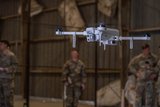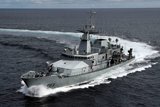Northrop Grumman hones US Space Force satellite design in virtual environment
The OPIR NGP satellites will provide sensor coverage over northern polar regions for the US Space Force. (Image: Northrop Grumman)
Northrop Grumman has refined the design of the Next-Generation Overhead Persistent Infrared (OPIR) Polar (NGP) satellite using Highly Immersive Virtual Environment (HIVE) technology. The satellites are being built for US Space Systems Command (SSC).
HIVE allows engineers to design, build, maintain and service satellites in virtual reality before hardware is manufactured or procured. Use of real-time modelling, simulation, visualisation and human interaction reduce technical costs and risks early in development phases.
The two NGP satellites will provide sensor coverage over the northern hemisphere to help deter and defend against ballistic and hypersonic missiles.
In a HIVE demonstration conducted at Northrop Grumman's Redondo Beach, California, site, engineers used VR goggles and motion-capture suits to simulate integration and assembly of key components. They validated the NGP design and will use the technology in the next stages of the satellites’ development.
In March 2022 Northrop Grumman announced its partnership with Ball Aerospace to design and develop the two NGP satellite payloads in the first phase of a $1.89 billion SSC contract.
More from Digital Battlespace
-
![Babcock nears first customer for Nomad AI translation tool]()
Babcock nears first customer for Nomad AI translation tool
Nomad can provide militaries with real-time intelligence, saving critical time on the battlefield.
-
![AUSA 2025: Israel’s Asio Technologies to supply hundreds of improved Taurus tactical systems]()
AUSA 2025: Israel’s Asio Technologies to supply hundreds of improved Taurus tactical systems
Taurus operates alongside the Israel Defense Forces’ Orion system which supports mission management across tens of thousands of manoeuvring forces, from squad leaders to battalion commanders.
-
![AUSA 2025: Kopin pushes micro-LED plans as China moves faster]()
AUSA 2025: Kopin pushes micro-LED plans as China moves faster
The plan for the new displays follows fresh investment in Kopin’s European facilities by Theon and an order for head-up displays in fielded aircraft, with funding from the US Department of Defense.
-
![AUSA 2025: Persistent Systems to complete its largest order by year’s end]()
AUSA 2025: Persistent Systems to complete its largest order by year’s end
Persistent Systems received its largest ever single order for its MPU5 devices and other systems earlier this month and has already delivered the 50 units to the US Army’s 4th Infantry Division.
-
![Aselsan brings in dozens of companies and systems under the Steel Dome umbrella]()
Aselsan brings in dozens of companies and systems under the Steel Dome umbrella
Turkey has joined the family of countries attempting to establish a multilayered air defence system with government approval in August 2024 for the effort landed by Aselsan. Dubbed Steel Dome, the programme joins Israel’s Iron Dome, the US Golden Dome, India’s Mission Sudarshan Chakra and South Korea’s low-altitude missile defence system.
-
![DSEI 2025: MARSS unveils new agnostic multidomain C4 system]()
DSEI 2025: MARSS unveils new agnostic multidomain C4 system
MARSS’ NiDAR system has been deployed using sensors from static platforms to provide detection and protection for static sights, such as critical infrastructure, ports and military bases.


























